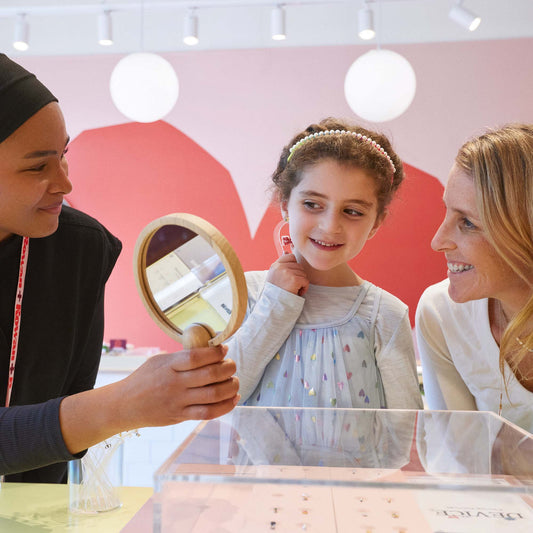Don't Freak Out! It’s Normal to Have Swelling and Bruising.

Walking out of a Rowan studio with a fresh new piercing can make you feel like a brand new person. You can’t wait to show it off to your friends the next day, but when you wake up and look in the mirror, you see some redness. You may start to freak out before you remember that a little redness is normal. So many things happen when we first get our ears pierced, and it can be hard to tell what’s normal and what isn’t. Luckily, we are here to help!
Normal findings
Slight Bleeding
A small amount of bleeding may happen at the time of piercing or during the weeks after, especially if you have bumped, snagged, or attempted to change your jewelry.
Bruising
Our ears have tiny blood vessels (called capillaries), and if they're nicked during the piercing, a small bruise will appear in the area. But don't worry, the bruise will naturally fade away with time. There’s no way to know beforehand if a piercing will create a bruise.
Redness
New piercings must undergo the same stages of healing that all wounds progress through. For many, this can mean some slight redness surrounding the piercing within the first week. You may also experience some redness if you accidentally bump or snag your piercing on an item of clothing or if you sleep on the piercing.
Swelling
Redness and swelling go hand-in-hand, and a small amount of swelling is completely normal. The swelling should never be so extensive that your earring is starting to “sink” into the ear. If this happens, you need to return to the studio to have the piercing sized with a larger post.
Discomfort
Most people expect some discomfort while getting pierced, but it’s normal to experience a dull, uncomfortable sensation as the piercing begins its healing process. A cool or warm compress can help temporarily alleviate the sensation, and you can always consult with your primary care provider to see if taking any over-the-counter medication is safe for you.
Clear drainage
This is probably the most unexpected normal finding, although not everyone will experience this. You may have some clear drainage as the piercing heals. This drainage often dries on the skin, leaving a “crust”-like film. If left on the skin, it can trap bacteria and dead skin cells, leading to infection. However, It’s important to not pick at it with your hands/fingernails. To remove the drainage, be sure to thoroughly rinse your piercing with warm water while taking a shower, and be sure to spray your aftercare on your piercings when you’re out of the shower. If needed, you can take a clean cotton swab and some aftercare to gently remove any drainage left behind.
Not Normal Findings
Excessive swelling / embedded earring
While a minor amount of swelling is normal (and expected) with new ear piercings, your ear should never be so swollen that the jewelry is “sinking” into the ear. This is called an embedded earring. If your earring is starting to become embedded, but you can still see the front and back, then return to the studio to have a longer earring post placed. If you can no longer see either the front or back of your earring, then seek medical attention to have the earring removed. Earrings becoming embedded is rare but can be a serious complication if not treated in a timely fashion.
Yellow-green drainage
Drainage that is yellow-green is different from clear drainage and can indicate an infection may be present. If you suspect that your piercing is infected, please seek medical care with your primary care provider for treatment.
Fever
Developing a fever may stem from a source outside of your piercing but still warrants being checked out by your doctor. A temperature of 101.4 degrees Fahrenheit or greater combined with any symptoms considered “not normal” can indicate that your piercing has an infection.
Redness without sleeping/pressure, snagging, after first couple of days
While redness is expected in the first couple of days after getting a new piercing, you can also experience some redness if you accidentally touch your piercing, sleep on it, or snag it on hair or clothing. What’s not normal is if you have a lot of redness outside of these reasons, which could indicate that your piercing is irritated or infected.
Remember, we are always here to support you! By staying informed about what to expect and when to seek help, you can ensure that your new piercing heals beautifully and remains a source of joy and self-expression. Remember, when in doubt, consult a professional to keep your piercing journey safe and satisfying.
The information provided should not be used for diagnosing or treating a health problem or disease. Information contained on this website is for informational purposes only. No material on this site is intended to be a substitute for professional medical advice, diagnosis, or treatment, and those seeking personal medical advice should consult with a licensed physician or other qualified healthcare provider.



